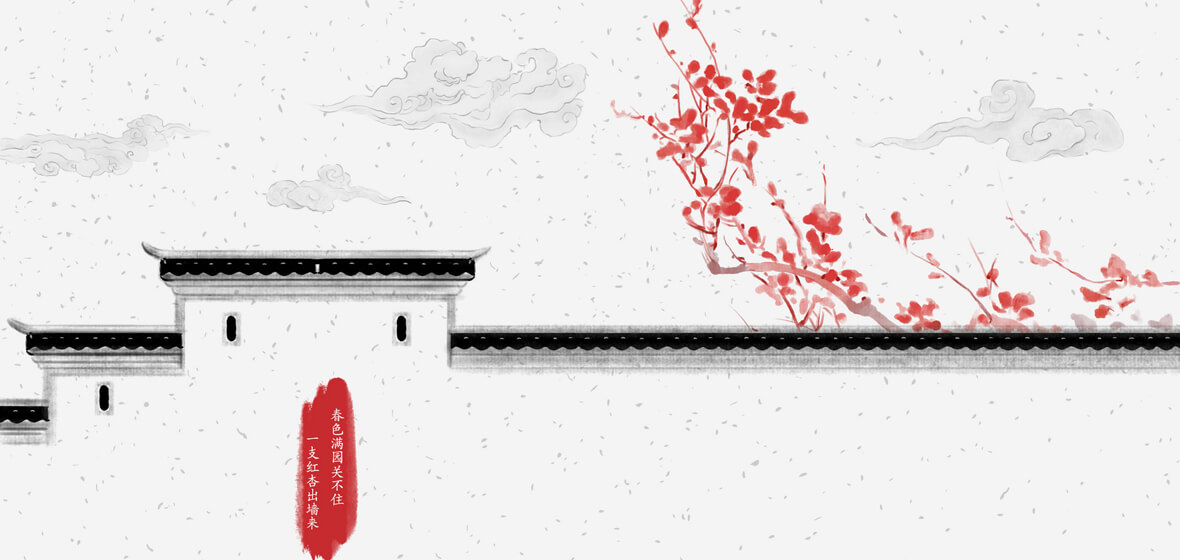
Poetry holds a supreme position in traditional Chinese literature and culture. The Book of Songs (Shijing), which dates back to around 600 BCE, is the earliest known collection of Chinese poems. Confucius considered this work to be a vital part of his educational curriculum, and he believed that mastering it was a necessary precondition for anyone entrusted with governmental affairs. Throughout the following dynasties, poetry's importance continued to grow. Scholars not only meticulously studied the Shijing as a Confucian classic, but they also devoted themselves to composing poetry in an increasingly diverse and intricate array of forms. Writing poetry became an essential means for them to express themselves, critique society, and even advance their careers. Outstanding poetic achievements could bring them both social prestige and access to official positions. The common people also actively participated in composing, reciting, and singing poetry. Their oral traditions played a crucial role in the development of all major Chinese poetic genres.
The Brief History of Classical Chinese Poetry
Classical Chinese poetry has a long and rich history spanning over two millennia. Its earliest known examples are found in the Book of Songs (Shijing), a collection of over 300 poems and songs from the Western Zhou Dynasty (11th-7th centuries BCE).
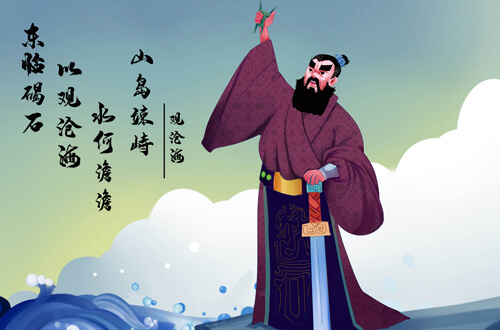
During the Tang Dynasty (618-907 CE), poetry flourished and reached its peak, with poets like Li Bai and Du Fu producing some of the most celebrated works in Chinese literature. Many of the Tang poems are known for their lyrical quality and vivid imagery, and they often explore themes of nature, love, and Buddhist philosophy. Tang Shi San Bai Shou (300 Tang Poems) is a compilation of poems from this period made around 1763 by Sun Zhu. Sun's collection became a "best seller" soon after its publication. It has been used for centuries since to teach elementary students to read and write, and also in cultivating character.
The Song Dynasty (960-1279 CE), saw the emergence of a new type of poetry known as ci, which was characterized by its use of set melodic patterns and strict tonal requirements. Ci poetry often drew on themes of nature, love, and morality, and was often set to music and performed in public.
During the Yuan Dynasty (1279-1368 CE), poetry saw further innovation with the development of qu, a type of poetry that combined elements of storytelling and drama. Qu poems often featured characters and dialogue and were designed to be performed in public.
The Ming Dynasty (1368-1644 CE), saw a revival of classical forms, with poets like Gao Qi and Wen Zhengming emphasizing the use of natural language and simple, heartfelt sentiment.
Throughout China's history, poetry played an important role in shaping and expressing the nation's cultural heritage and social identity. The Chinese language's rich imagery, symbolism, and tonal qualities have enabled poets to create works that are both beautiful and highly nuanced. Today, ancient Chinese poetry continues to be celebrated and studied around the world, both for its literary significance and its insights into Chinese history and culture.
What is The Book of Songs (Shijing)?
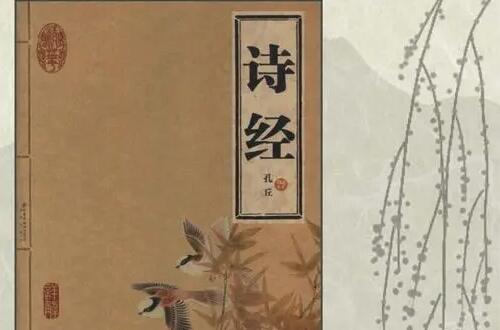
The Book of Songs, also known as the "Shijing" (诗经) or "Classic of Poetry," is an ancient Chinese collection of poems that dates back to the Western Zhou Dynasty (1046-771 BCE) and the Spring and Autumn Period (770-476 BCE). The "Shijing" is one of the Five Classics (五经) of Confucianism, a group of key texts that form the foundation of Confucian thought and Chinese culture. The "Shijing" is not only a collection of lyrical and narrative poems. It also serves as a valuable historical document that offers an insight into the society, culture, and politics of ancient China. The poems touch on various themes, including love, war, work, and harvest, and showcase diverse poetic forms and styles. The "Shijing" has played a significant role in the development of Chinese literature, and its influence can be seen in various forms of poetry that followed.
The "Shijing" comprises 305 poems, divided into three sections: "Feng" (风 or "Airs"), "Ya" (雅 or "Odes"), and "Song" (颂 or "Hymns"). These poems were collected from various regions of ancient China, thus reflecting the diverse customs, dialects, and traditions from that time period.
- "Feng" (风): Consists of 160 poems that express the daily life, emotions, and thoughts of common people, often providing insights into their social and political conditions.
- "Ya" (雅): Contains 105 poems, further divided into "Lesser Ya" (小雅) and "Greater Ya" (大雅), which typically focus on moral teachings and social themes, portraying the values and perspectives of the ruling class, as well as the poet's reflections on societal issues.
- "Song" (颂): Features 40 hymns addressed to the deities or ancestors in ceremonial settings, reflecting religious practices and beliefs, as well as the political events of the time. The hymns are further divided into "Hymns of Zhou" (周颂), "Hymns of Shang" (商颂), and "Hymns of Lu" (鲁颂).
What Are the Main Types of Poetry in Ancient China?
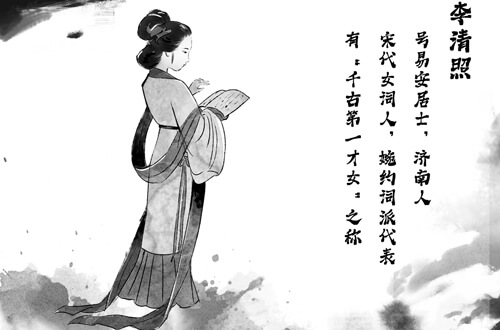
Over the next 2000 years, classical Chinese poetry morphed and expanded into many different forms through various dynasties. Ancient Chinese poetry is known for its strict adherence to formal rules and its use of complex imagery and symbolism. Each type of poetry has its own unique characteristics and themes, but all are highly valued for their beauty and cultural significance.
There are several main types of ancient Chinese poetry, including:
- Shi (诗) - This is the most common type of ancient Chinese poetry, which is characterized by its strict adherence to a set of tonal patterns and syllable counts. Shi can be further divided into various subcategories, such as fu, ci, and qu.
- Fu (赋) - This type of poetry is characterized by its vivid descriptions and detailed imagery. Fu often describes a particular scene or object in great detail, and is often used to celebrate the achievements of a particular individual or dynasty.
- Ci (词) - This type of poetry is characterized by its use of a fixed tonal pattern and a limited number of syllables. Ci often focuses on themes of love and romance, and is often set to music.
- Qu (曲) - This type of poetry is similar to ci, but is specifically designed to be sung. Qu often tells a story or describes a particular scene, and is characterized by its use of a fixed tonal pattern and a limited number of syllables.
What Are the Main Themes and Its Examples of Classical Chinese Poetry?
The main themes of poetry in ancient China are varied and reflect the cultural, philosophical, and social values of the time. Here are some of the main themes of ancient Chinese poetry:
Nature and the Natural world
Ancient Chinese poets often wrote about the beauty and power of nature, including mountains, rivers, and other natural landscapes. They often used nature as a metaphor for human emotions and experiences.
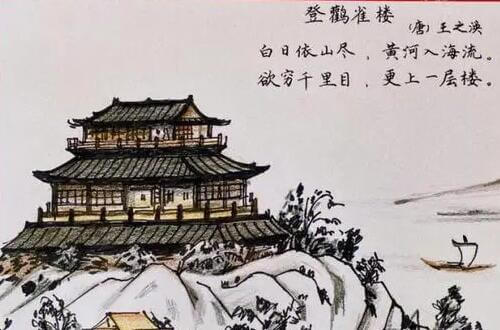
登鹳雀楼 (Ascending the Stork Tower)
By Wang Zhihuan
白日依山尽,黄河入海流。
The sun sets behind the mountains, the Yellow River flows into the sea.
欲穷千里目,更上一层楼。
To take in the full sight of a thousand miles, climb one more level of the tower.
The poem, penned by Chinese poet Wang Zhihuan, hails from the magnificent era of the Tang Dynasty (618-907CE). Contemporary Chinese individuals often draw on these verses to inspire young people to strive for a brighter future or to illustrate partnerships among nations, characterized by their expansiveness and vividness, akin to the vast panorama depicted in the opening line, while promoting mutual growth through long-term perspectives.
Love and Romance
Love and romance were popular themes in ancient Chinese poetry, particularly in the ci and qu forms. Poets often wrote about the joys and sorrows of love, as well as the beauty and virtues of their beloved.
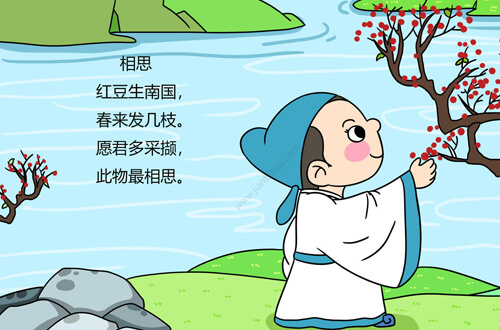
相思(Yearning)
By Wang Wei
红豆生南国,春来发几枝。
In the land to the south, red beans grow and blossoms in the spring.
愿君多采撷,此物最相思。
Oh, my love, I wish you'd gather more, for these beans symbolize the yearning we bring.
Politics and Society
Many ancient Chinese poets wrote about political and social issues of their time. They often criticized corrupt officials and praised virtuous leaders, and wrote about the struggles of common people.
示儿 (To My Son)
By Lu You
死去元知万事空,但悲不见九州同。
Upon death, one realizes all things are empty; only sorrowful that the world is not united.
王师北定中原日,家祭无忘告乃翁。
On the day when the royal forces subdue the north and pacify the Central Plain,
Do not forget to pay tribute to your ancestors during family rituals.
The poem was written during the Southern Song Dynasty (1127-1279CE). The Southern Song Dynasty was a turbulent and challenging period in Chinese history, marked by political strife and military conflicts.
In 1127, the Northern Song Dynasty (960-1127CE) fell to the invading Jurchen Jin Dynasty (1115-1234CE), which led to the partial occupation of northern China including the central plains. Many of the imperial family, nobility, and surviving skilled officials fled to southern China, where they established the Southern Song Dynasty with its capital at Lin'an (modern-day Hangzhou).
Throughout its existence, the Southern Song Dynasty struggled to regain the lost territories in the north. There were a series of military campaigns, known as the "Jin–Song Wars," and the Southern Song Dynasty achieved some success, but ultimately failed to reclaim the entire northern region.
The historical background of Lu You's poem, "示儿" (To My Son), is closely tied to this tumultuous era. Lu You is lamenting the disunity caused by the North-South divide and expressing his yearning for a unified China. He encourages his son to maintain hope, and when the day of reunification eventually comes, to remember and honor their ancestors who also longed for such unity.
Philosophy and Spirituality
Ancient Chinese poetry often reflected the philosophical and spiritual beliefs of the time, including Confucianism, Taoism, and Buddhism. Poets often explored concepts such as the nature of reality, the meaning of life, and the pursuit of enlightenment.
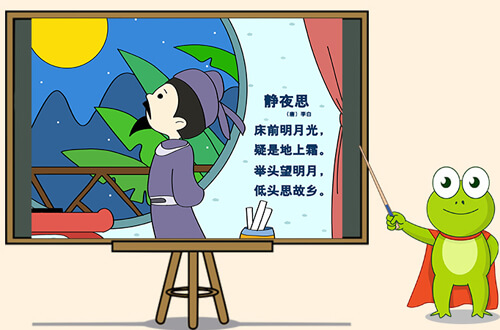
静夜思 Thoughts on a Quiet Night
By Li Bai (or Li Po)
床前明月光,疑是地上霜。
Before my bed, the bright moonlight appears like frost on the ground.
举头望明月,低头思故乡。
Raising my head, I gaze at the bright moon; lowering my head, I think of my hometown.
This is a poem of nostalgia for Li Bai's hometown while he's far away and is often taught to Chinese elementary school students.
History and Mythology
Ancient Chinese poets often drew inspiration from historical events and figures, as well as from mythology and folklore. They wrote about legendary heroes, gods and goddesses, and other mythical creatures.
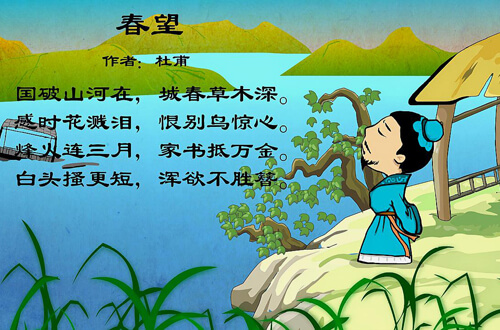
春望 (View in Springtime)
By Du Fu
国破山河在,城春草木深。
A kingdom smashed, its hills and rivers still here,
Spring in the city, plants and trees grow deep.
感时花溅泪,恨别鸟惊心。
Moved by the moment, flowers splash with tears,
Distressed at parting, birds startle the heart in fear.
Du Fu lived during the Tang Dynasty (618-907CE), which is often considered the golden age of Chinese culture and arts. However, the dynasty experienced significant political turmoil, particularly during the An Lushan Rebellion from 755 to 763.
The An Lushan Rebellion was led by a general named An Lushan, who sought to establish his own regime by overthrowing the Tang Dynasty. The rebellion caused widespread chaos and devastation, leading to the deaths of millions of people and severely weakening the once-great Tang Empire.
"View in Springtime" is set against this backdrop of chaos and destruction. The poem captures the sentiments of despair and the passage of time as the natural world continues while human society suffers. It highlights the scars left on the people and their land after war and the resilience of nature amid turmoil. Du Fu's masterful use of language and imagery conveys the poignant emotions he experienced during this period.
Overall, ancient Chinese poetry is known for its rich imagery, symbolism, and depth of meaning. The themes explored in ancient Chinese poetry continue to resonate with readers today and offer insights into the culture and history of China.
 Poems About Yellow River
Poems About Yellow River 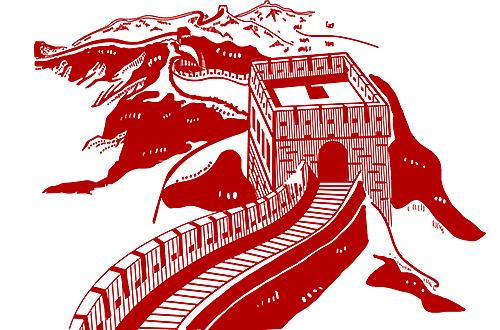 2 Poems about the Great Wall
2 Poems about the Great Wall  Qingming Festival Poems
Qingming Festival Poems 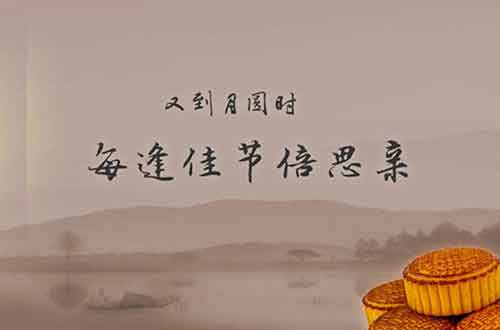 2 Popular Chinese Mid-Autumn Festival Poems
2 Popular Chinese Mid-Autumn Festival Poems